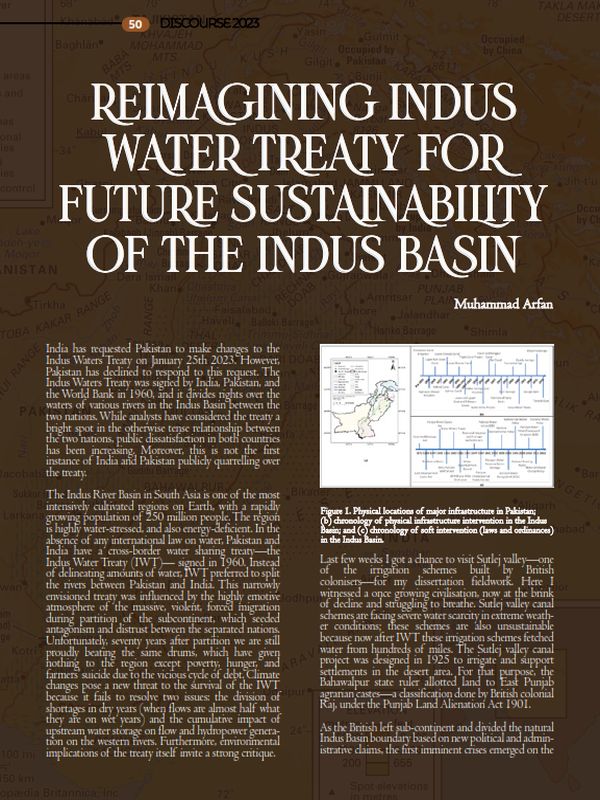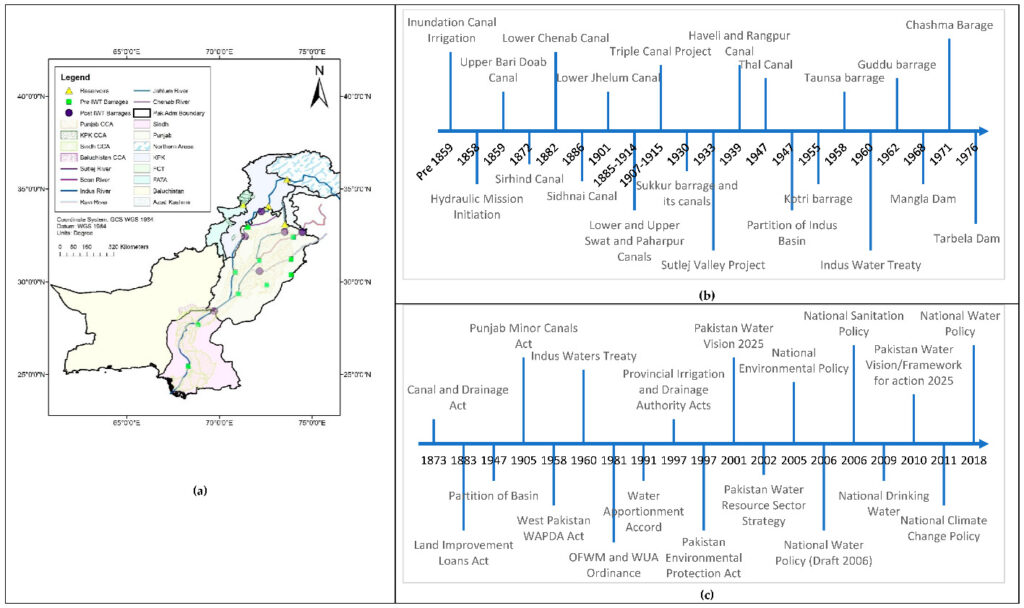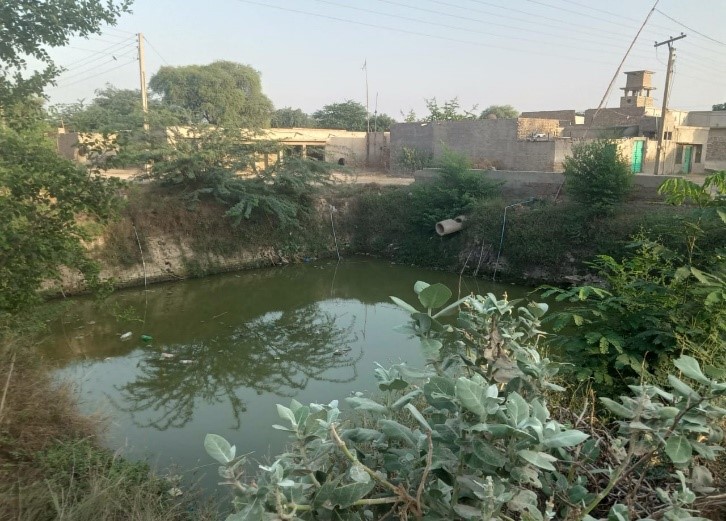Reimagining Indus Water Treaty for Future Sustainability of the Indus Basin
India has requested Pakistan to make changes to the Indus Waters Treaty on January 25th 2023. However, Pakistan has declined to respond to this request. The Indus Waters Treaty was signed by India, Pakistan, and the World Bank in 1960, and it divides rights over the waters of various rivers in the Indus Basin between the two nations. While analysts have considered the treaty a bright spot in the otherwise tense relationship between the two nations, public dissatisfaction in both countries has been increasing. Moreover, this is not the first instance of India and Pakistan publicly quarrelling over the treaty.
The Indus River Basin in South Asia is one of the most intensively cultivated regions on Earth, with a rapidly growing population of 250 million people. The region is highly water-stressed, and also energy-deficient. In the absence of any international law on water, Pakistan and India have a cross-border water sharing treaty—the Indus Water Treaty (IWT)— signed in 1960. Instead of delineating amounts of water, IWT preferred to split the rivers between Pakistan and India. This narrowly envisioned treaty was influenced by the highly emotive atmosphere of the massive, violent, forced migration during partition of the subcontinent, which seeded antagonism and distrust between the separated nations. Unfortunately, seventy years after partition we are still proudly beating the same drums, which have given nothing to the region except poverty, hunger, and farmers’ suicide due to the vicious cycle of debt. Climate changes pose a new threat to the survival of the IWT because it fails to resolve two issues: the division of shortages in dry years (when flows are almost half what they are on wet years) and the cumulative impact of upstream water storage on flow and hydropower generation on the western rivers. Furthermore, environmental implications of the treaty itself invite a strong critique.
Figure 1. Physical locations of major infrastructure in Pakistan; (b) chronology of physical infrastructure intervention in the Indus Basin; and (c) chronology of soft intervention (laws and ordinances) in the Indus Basin.
Last few weeks I got a chance to visit Sutlej valley—one of the irrigation schemes built by British colonisers—for my dissertation fieldwork. Here I witnessed a once growing civilisation, now at the brink of decline and struggling to breathe. Sutlej valley canal schemes are facing severe water scarcity in extreme weather conditions; these schemes are also unsustainable because now after IWT these irrigation schemes fetched water from hundreds of miles. The Sutlej valley canal project was designed in 1925 to irrigate and support settlements in the desert area. For that purpose, the Bahawalpur state ruler allotted land to East Punjab agrarian castes—a classification done by British colonial Raj, under the Punjab Land Alienation Act 1901.
As the British left sub-continent and divided the natural Indus Basin boundary based on new political and administrative claims, the first imminent crises emerged on the division of the Indus Basin water; during the first war over Kashmir, India cut off the water supply from its headworks from flowing to Pakistan. This unilateral decision to use control over the Eastern Rivers water as a weapon of mass destruction caused one million acres of irrigated land in Pakistan to go into drought. Pakistan’s Prime Minister, Mr. Liaqat Ali Khan, considered this action as “foundational violence” and declared water as “new front of tension”. This action provides a basis for the current lack of “hydro-solidarity” among the new neighbouring countries and rolled out the joint technical management proposal of the World Bank for the Indus Basin.
Pakistan secured rights to the Western Rivers and diverted water from the Western rivers to the Eastern Rivers canal command through a massive river interlinking canal development project. On the upstream side, India built an array of water projects on the Eastern Rivers and tried their best to stop each drop of water flow in to the Eastern Rivers.
After Uri’s attack in 2016, Prime Minister Narendra Modi convened a national ministry of water resources meeting and said, “blood and water can’t flow together,” stressing the completion of any under-developed water schemes on the Eastern Rivers so that each drop of water was utilised within Indian borders. Since 1960, when the IWT was signed, both India and Pakistan have consistently moved towards a highly conservative resource nationalism discourse to secure future water rights; with each passing day, water crises are impeding the economic development of both neighbouring nations due to the lack of cooperation. Pakistan is struggling to sustain the Sutlej Valley canal project scheme through long-distance water diversion from western rivers; a significant amount of this precious resource is lost in conveyance, consequently increasing challenges with waterlogging and salinity along these inter-rivers linking canals.
Figure 2. Showing a typical design of Indus Basin canal settlement. A water pond designed in the central square of each residential settlement (aka chak— numbered according to canal command distributory) for drinking purpose. People (mostly this job associated with women) fetched water from pond before electricity, but now electric motors installed by each resident and water is conveyed through pipes as shown in figures. Water pond is feed through a canal water on a weekly schedule.
In a recent visit to Sutlej valley canal schemes, I realiaed how this agricultural growth model is hardly surviving, providing a meagre amount of return compared to its potential. These canal projects provide water to the country’s largest export textile industry. In almost 70 years since the IWT, Pakistan policymakers have never seriously considered alternate water sources for this canal command, or how it could be sustained through a substitute route in an efficient manner with a more flexible and dynamic IWT.
Few years ago, Adriano Vinca and his colleagues performed an economic analysis and estimate that Indus basin countries need to increase investments to USD 10 billion per year to mitigate water scarcity issues and ensure improved access to resources by 2050. These costs could shrink to USD 2 billion per year, with economic gains for all, if countries pursued more collabourative policies for water sharing. These glaring economic benefits are shocking for me and forced me to think over this issue: why our policy makers are not thinking on these lines?
These sorts of economic rationales provide enough impetus for policy makers to understand that the time has come for a radical envisioning of the Indus Basin to meet Sustainable Developmental Goals (SDGs). SDGs 6.5.2 rightly emphasis transboundary cooperation because the lack of poses a massive cost in terms of economic well-being as well as global peace. Currently, resource nationalism discourse is dominated by state actors limiting the participation of multiple non-state actors for any new possible praxis of cooperation.
Unfortunately, in this regard, the IWT does not comply with the UN Watercourse Convention, 1997 Article 9 Clause 1 that states, “watercourse states shall on a regular basis exchange readily available data and information on the condition of the watercourse, in particular that of a hydrological, meteorological, hydrogeological and ecological nature and related to the water quality as well as related forecasts”. The IWT have a data exchange mechanism, but it is very limited in scope and also not readily available to the people at stake—water resource managers, farmers, and policy makers. The current and future sustainability of the Indus Basin under changing climate realities demands that we adjust existing water agreements and institutions for effective, equitable, and environmentally-just transboundary water governance adaptive framework.
There is a need to drag out this important discussion from the comfort of elite spaces and engage a people-to-people interaction for exploring transboundary hydro-solidarity avenues. People-to-people interaction might help construct a narrative based on common bonds of history, culture, and more importantly an eco-friendly religious faith tradition on both sides.
The author ([email protected]) writes about water governance, climate, and community participation and tweets at @Muhamma04818452. He recently finished his PhD in Integrated Water Resources Management. He previously worked as Senior Project Officer with the Sustainable Agriculture & Food Programme of the WWF-Pakistan.









